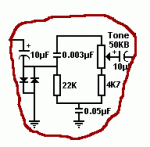bifurcation
Well-known member
Hey all,
I've been (largely unsuccessfully) trying to get my head around different tone stack circuits, and as an exercise I'm trying to mod a Foxx Tone Machine clone to adapt it for bass.

Looking at the input, and using a filter calculator, it looks like the 1M resistor and .1 uF capacitor trims off everything below 1.6 Hz, which is fine for guitar or bass.
From the little I understand, when I focus on the tone stack:

I think it works like:

Turn the knob to the left, it pulls signal through the upper capacitor and... uh... sends to ground through the 22K resistor?
Which makes it filter around 2,413 Hz?
Alternatively:

Turn the knob to the right, it pulls signal... past the lower capacitor and... uh... through the 4K7 resistor?
Which makes it filter around 678 Hz?
So, assuming any of that is correct, (which I'm doubting the more I write this out,) could I just pull out that 4K7 and replace it with a 120K to bring the low end response down to around 26 Hz? (the low A on a drop-tuned 5-string bass)
I've been (largely unsuccessfully) trying to get my head around different tone stack circuits, and as an exercise I'm trying to mod a Foxx Tone Machine clone to adapt it for bass.

Looking at the input, and using a filter calculator, it looks like the 1M resistor and .1 uF capacitor trims off everything below 1.6 Hz, which is fine for guitar or bass.
From the little I understand, when I focus on the tone stack:

I think it works like:

Turn the knob to the left, it pulls signal through the upper capacitor and... uh... sends to ground through the 22K resistor?
Which makes it filter around 2,413 Hz?
Alternatively:

Turn the knob to the right, it pulls signal... past the lower capacitor and... uh... through the 4K7 resistor?
Which makes it filter around 678 Hz?
So, assuming any of that is correct, (which I'm doubting the more I write this out,) could I just pull out that 4K7 and replace it with a 120K to bring the low end response down to around 26 Hz? (the low A on a drop-tuned 5-string bass)





